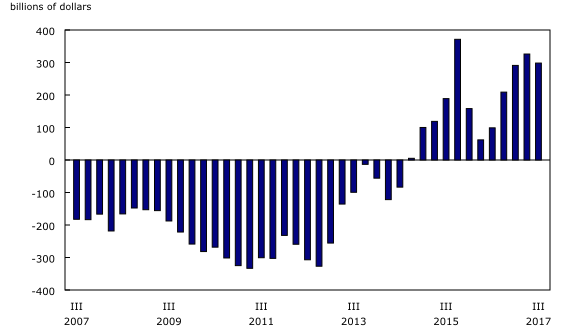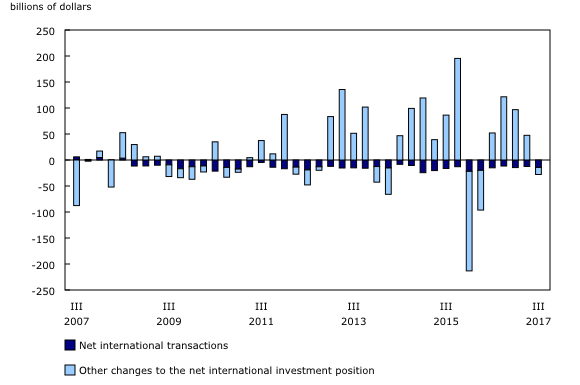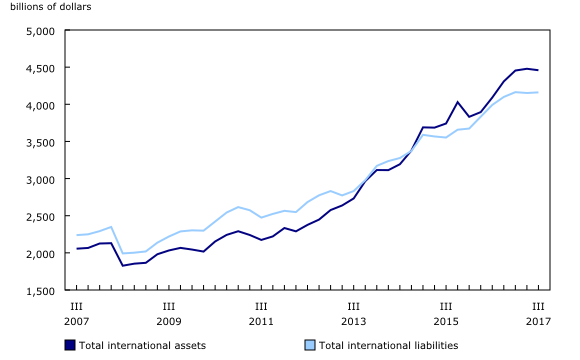Canada's international investment position, third quarter 2017
Archived Content
Information identified as archived is provided for reference, research or recordkeeping purposes. It is not subject to the Government of Canada Web Standards and has not been altered or updated since it was archived. Please "contact us" to request a format other than those available.
Released: 2017-12-13
$298.3 billion
Third quarter 2017
Canada's net foreign asset position fell by $27.9 billion to $298.3 billion in the third quarter, following four consecutive quarterly increases.
The reduction mainly reflected the effect (-$79.8 billion) of an appreciating Canadian dollar, which lowered the value of foreign currency-denominated assets and liabilities when converted to Canadian dollars. In the third quarter, 96% of Canada's international assets were denominated in foreign currencies, compared with 37% for international liabilities.
The stronger performance of foreign stock markets relative to the Canadian stock market moderated the overall decline in the net foreign asset position in the quarter.
Over the third quarter of 2017, the Canadian dollar gained 4.0% against the US dollar, 0.5% against the euro, 0.9% against the British pound and 4.2% against the Japanese yen. The Canadian stock market rose by 3.0%, compared with gains of 4.0% in the United States and 4.4% in the European stock markets (as measured by the Standard and Poor's 500 and the EuroStoxx).
Canada's international assets down on a stronger Canadian dollar
Canada's international financial assets were down $19.6 billion to $4,458.6 billion at the end of the third quarter. The decrease mainly resulted from a downward revaluation effect of $130.3 billion due to the appreciation of the Canadian dollar against major foreign currencies. The growth of foreign stock markets moderated the overall decrease.
On an instrument type basis, Canadian holdings of foreign equity instruments increased by $26.7 billion to $3,182.4 billion in the third quarter. In addition to higher foreign stock prices, investment by Canadian direct investors in foreign affiliates contributed to the growth.
Meanwhile, Canadian holdings of foreign debt instruments were down by $46.3 billion to $1,276.2 billion. Currency and deposits held abroad by Canadians declined by $28.0 billion to $346.9 billion. At the end of the third quarter, 85% of Canada's international assets in currency and deposits were denominated in foreign currencies.
Canada's international liabilities edge up
Canada's international liabilities edged up $8.3 billion to $4,160.4 billion in the third quarter. The stronger Canadian dollar reduced the value of liabilities by $50.5 billion over the quarter. This change was more than offset by foreign acquisitions and higher Canadian equity prices.
Canadian equity instruments held by foreign direct and portfolio investors increased by $57.6 billion to $1,829.7 billion at the end of the quarter, led by higher equity prices. Foreign portfolio investors held $654.0 billion of Canadian equity and investment fund shares, up $22.2 billion from the second quarter, with most of the growth in shares from the trade and transportation sector.
Foreign holdings of Canadian debt instruments, also referred to as Canada's gross external debt, were down by $49.3 billion to $2,330.7 billion in the third quarter. The decline was mainly in the banking sector, on lower currency and deposits held by non-residents. Higher foreign holdings of Canadian bonds moderated the overall decline in liabilities due to strong acquisition activity in the quarter. Nearly two-thirds of Canada's gross external debt were denominated in foreign currencies at the end of the third quarter.
Canada's international assets are more exposed to currency fluctuations than liabilities
The currency composition of Canada's international financial assets differs from the composition of its international liabilities, as a higher proportion of the assets are denominated in foreign currencies than the liabilities.
At the end of the third quarter, 62% or $2,746.9 billion of Canada's total international assets were denominated in US dollars, followed by the euro (10%), British pound (6%) and Canadian dollar (4%).
On the other hand, 63% of the country's international liabilities were denominated in Canadian dollars in the third quarter. International liabilities denominated in US dollars represented 29% of all liabilities, followed by the euro at less than 4%.
As a result, fluctuations of the Canadian dollar against foreign currencies have a more important impact on the value of Canada's international financial assets compared with its international liabilities.

In celebration of the country's 150th birthday, Statistics Canada is presenting snapshots from our rich statistical history.
Estimates of Canadian holdings of foreign securities by individual country of investment are available on an annual basis from 1997 and on a quarterly basis from 2013. Canadian investors had 62% of their portfolio invested in US securities at the end of the third quarter of 2017, compared with a 50% share in 2007 just prior the financial crisis. This share was at 56% in 1997.
Canadian holdings of foreign equities accounted for 80% of total holdings at the end of the third quarter of 2017 compared with a high of 91% in 1999. The composition of portfolio investment abroad in favour of equities is also a pattern observed in the United States, but stands in contrast to most other major investing countries. European countries such as United Kingdom, Germany and France, as well as Japan, have a higher share of their portfolio assets held in the form of debt securities.
Canadian portfolio investment abroad was spread over more than 100 countries at the end of the third quarter of 2017. The top five destinations were the United States, the United Kingdom, Japan, France and Germany.
Note to readers
This release incorporates new information on the currency composition of Canada's international financial assets and liabilities. These new data provide additional insights on the nature of Canada's balance sheet vis-à-vis non-residents as well as an enhanced measure of the foreign exposure of Canadian investors. Data are available in CANSIM table 376-0150.
Revisions
This release also incorporates statistical revisions back to the first quarter 2014 as part of the annual revision exercise of the Canadian System of Macroeconomic Accounts. Revisions reflect the integration of new data sources as well as improved methodologies. The most noticeable improvement relates to the estimates of foreign holdings of Canadian equity and investment fund shares. These holdings are now generated using individual share prices at period-end as opposed to aggregated stock indices. This new approach results in more frequent, timely and accurate estimates.
Currency valuation
The value of assets and liabilities denominated in foreign currency is converted to Canadian dollars at the end of each period for which a balance sheet is calculated. When the Canadian dollar is appreciating in value, the restatement of the value of these assets and liabilities in Canadian dollars lowers the recorded value. The opposite is true when the Canadian dollar is depreciating.
Definitions
The international investment position presents the value and composition of Canada's assets and liabilities to the rest of the world.
Canada's net international investment position is the difference between Canada's assets and liabilities to the rest of the world. An excess of international liabilities over assets can be referred to as Canada's net foreign debt. An excess of international assets over liabilities can be referred to as Canada's net foreign assets.
Foreign direct investment is presented on an asset-liability principle basis (that is, gross basis) in the international investment position. Foreign direct investment can also be presented on a directional principle basis (that is, net basis), as shown in supplementary foreign direct investment tables, CANSIM 376-0051 and 376-0052. The difference between the two foreign direct investment conceptual presentations resides in the classification of reverse investment such as (1) Canadian affiliates' claims on foreign parents and (2) Canadian parents' liabilities to foreign affiliates. Under the asset/liability presentation, (1) is classified as an asset and included in direct investment assets, and (2) is classified as a liability and included in direct investment liability.
Products
The Methodological Guide: Canadian System of Macroeconomic Accounts (13-607-X) is available.
The User Guide: Canadian System of Macroeconomic Accounts (13-606-G) is also available. This publication will be updated to maintain its relevance.
The updated Canada and the World Statistics Hub – United States (13-609-X) is available from the home page of the Statistics Canada website. This new product illustrates the nature and the extent of Canada's economic and financial relationship with the United States using interactive graphs and tables. This product provides an easy access to information on trade, investment, employment and travel, including merchandise trade by Canadian provinces and US states.
Contact information
For more information, contact us (toll-free 1-800-263-1136; 514-283-8300; STATCAN.infostats-infostats.STATCAN@canada.ca).
To enquire about the concepts, methods or data quality of this release, contact Vicky Gélinas (613-716-2828; vicky.gelinas@canada.ca), International Accounts and Trade Division.
- Date modified:




